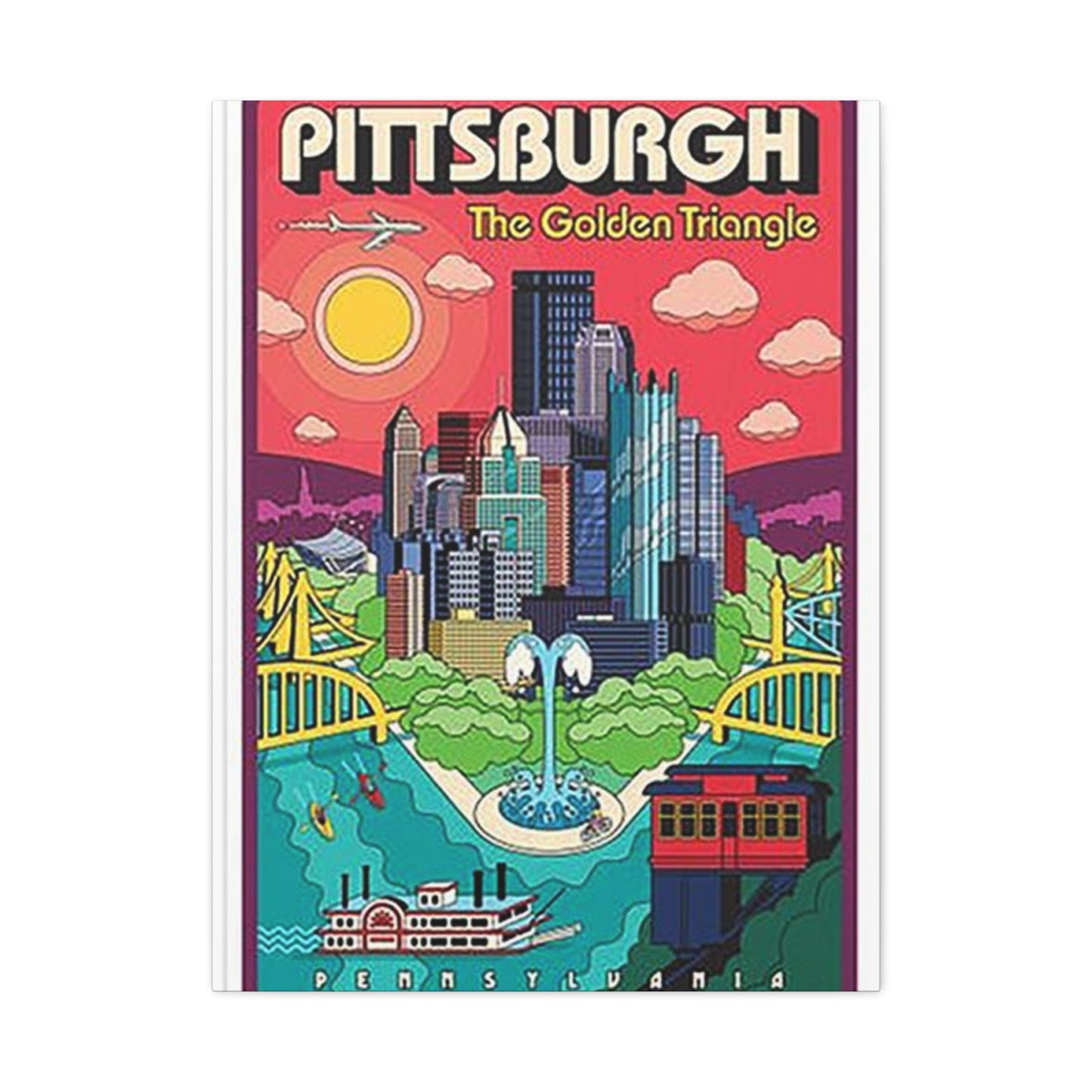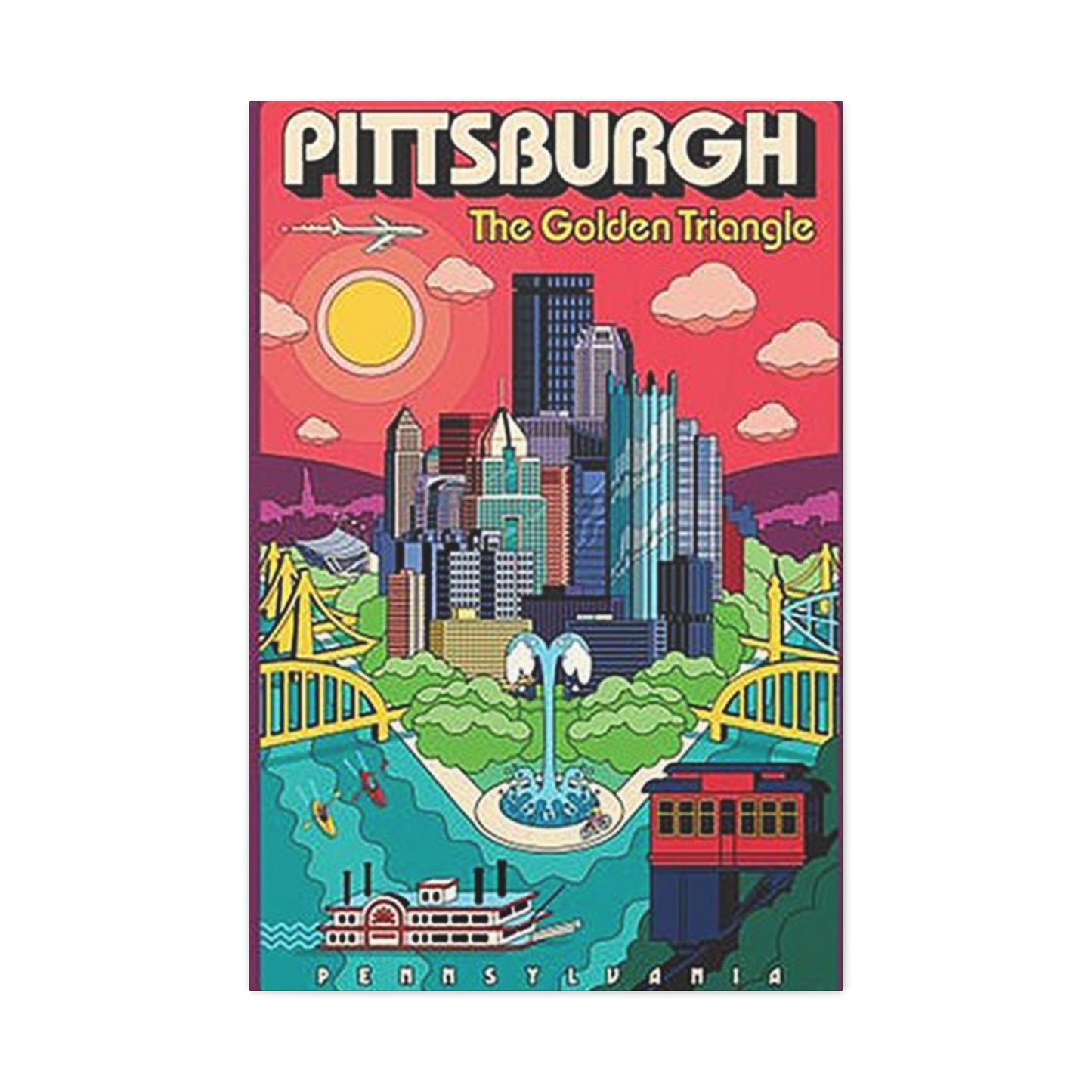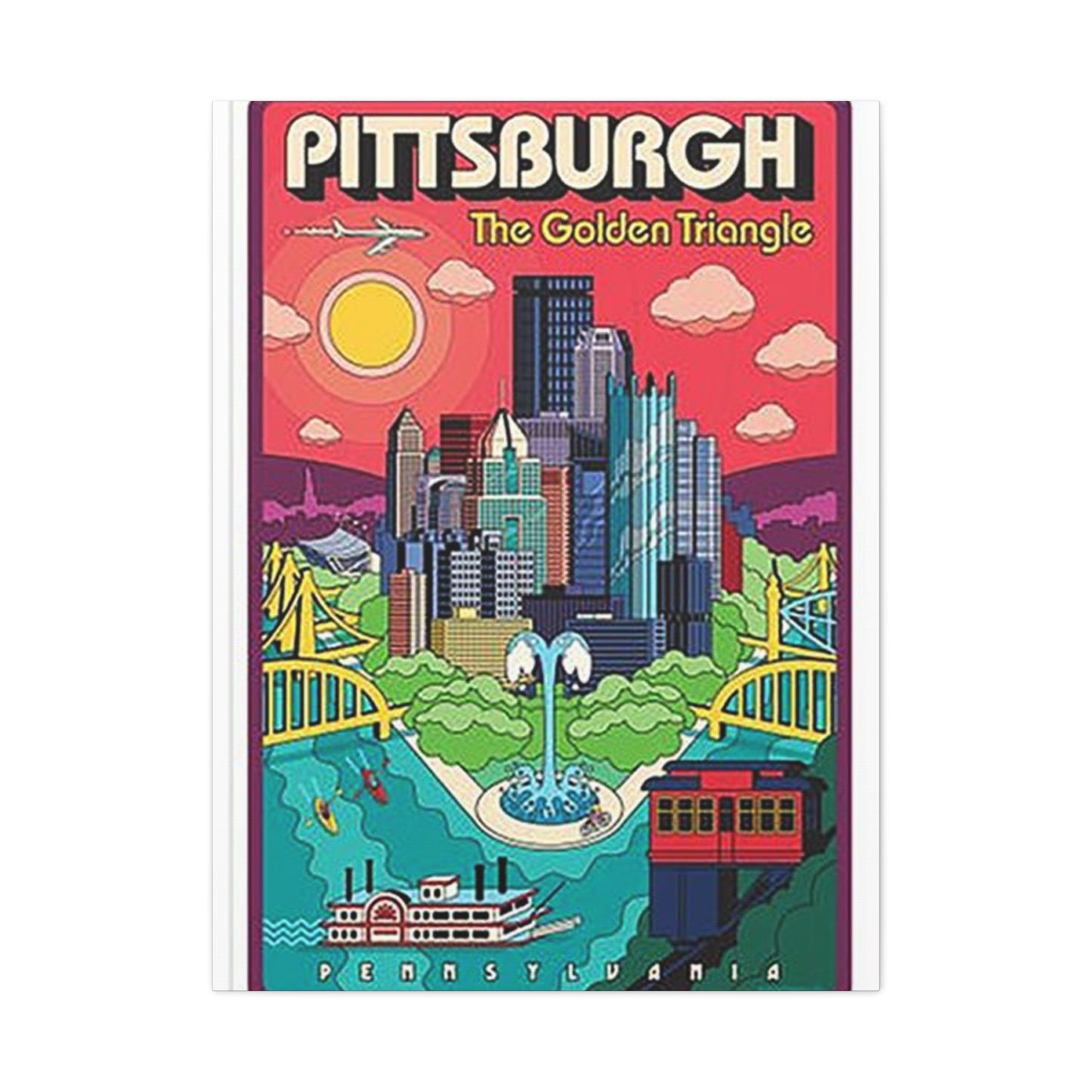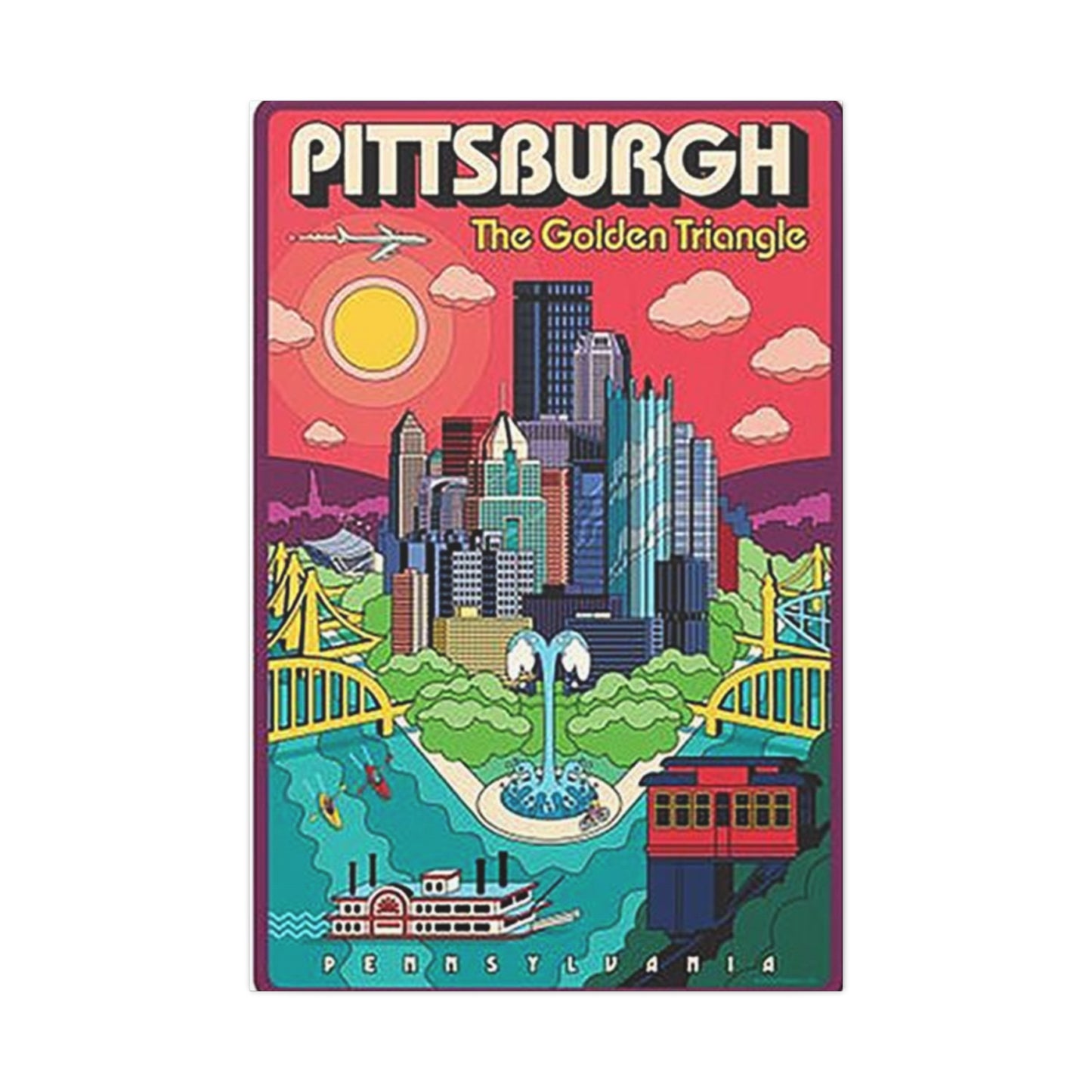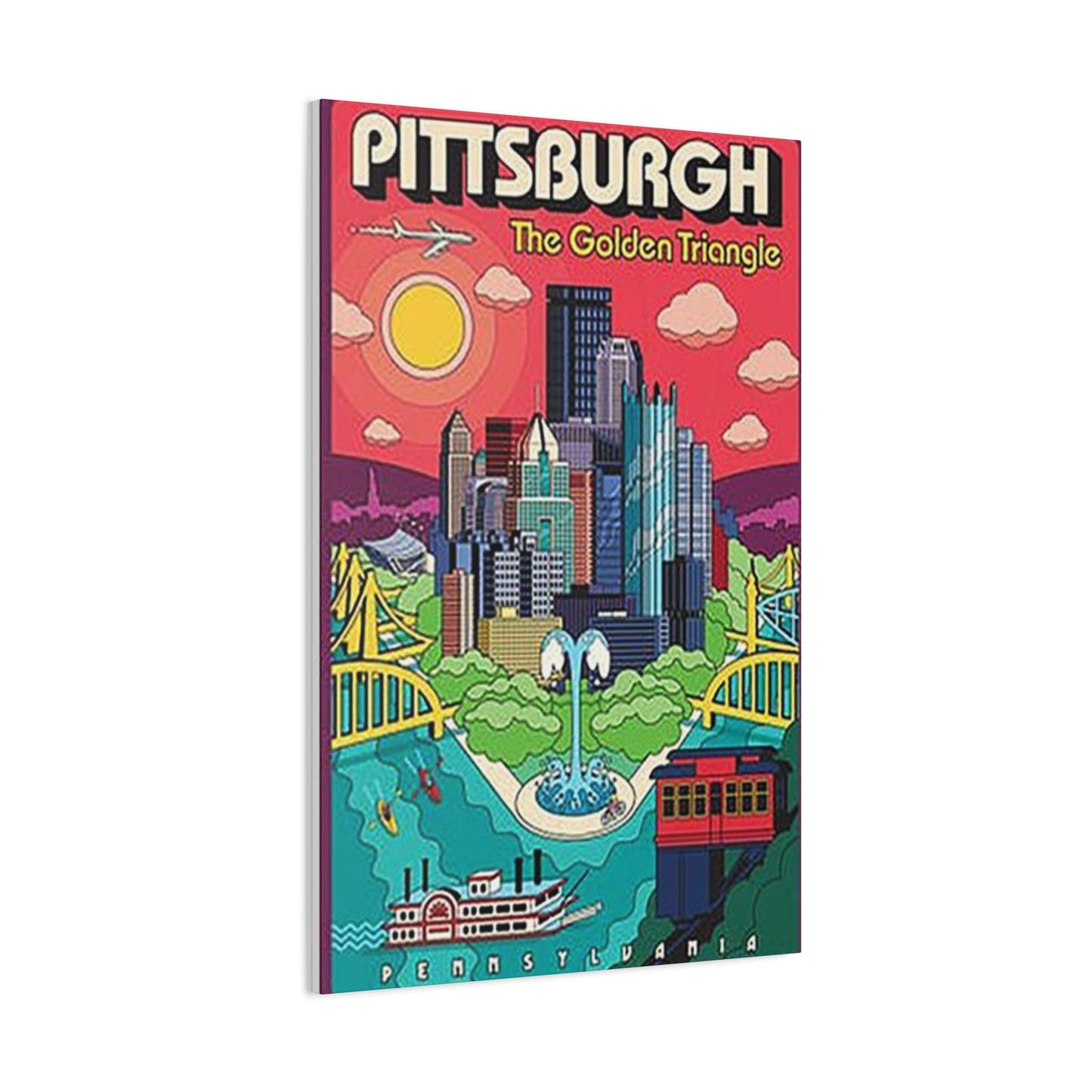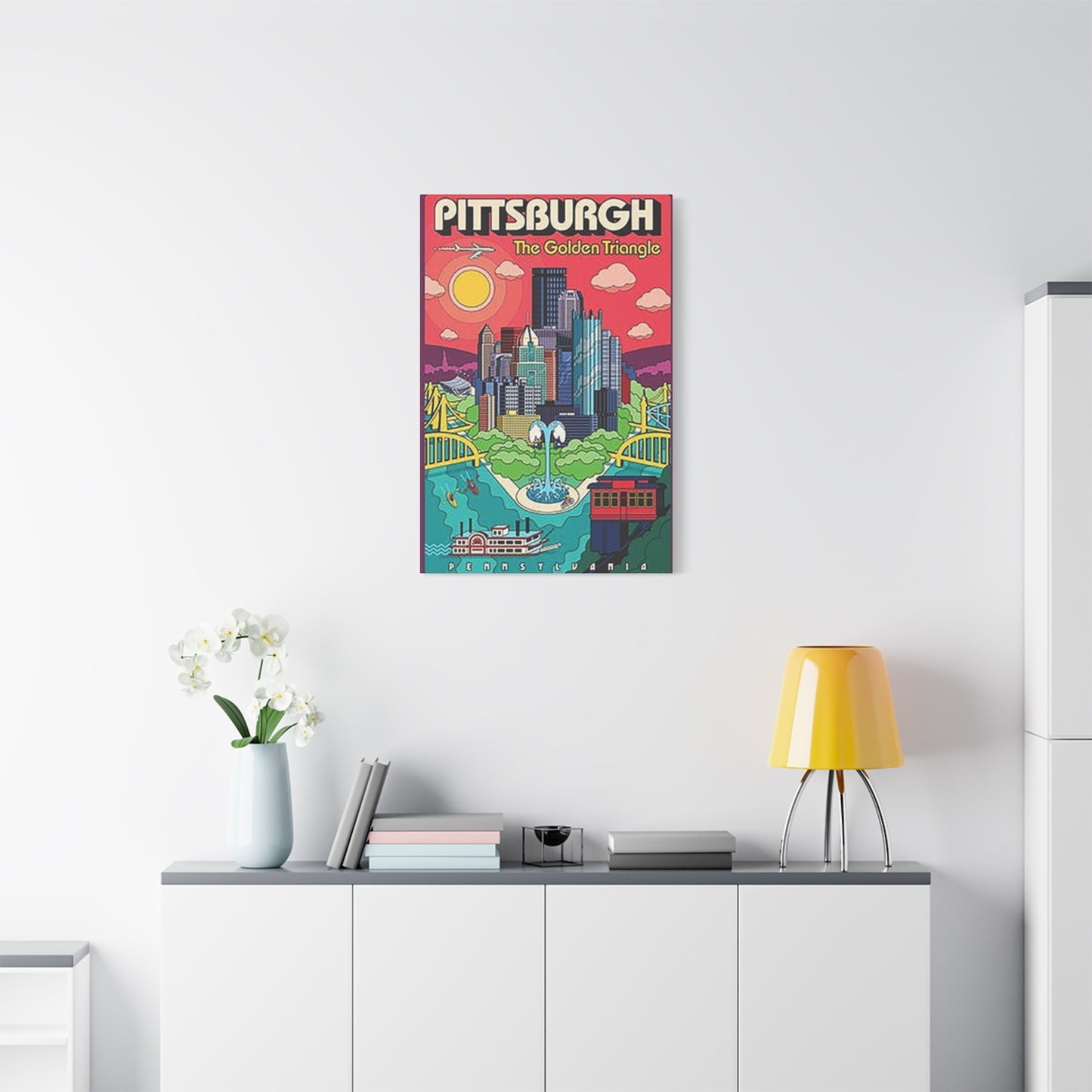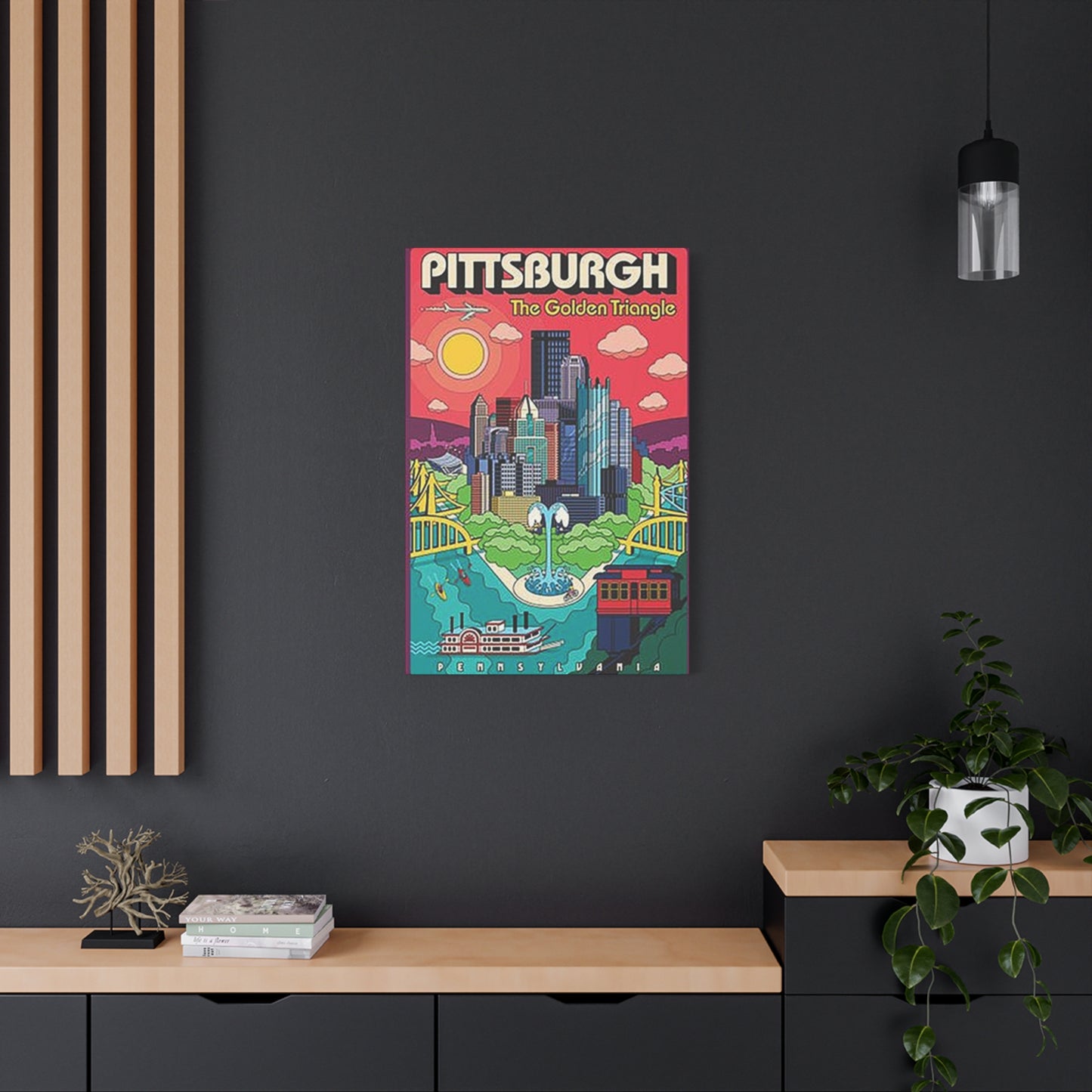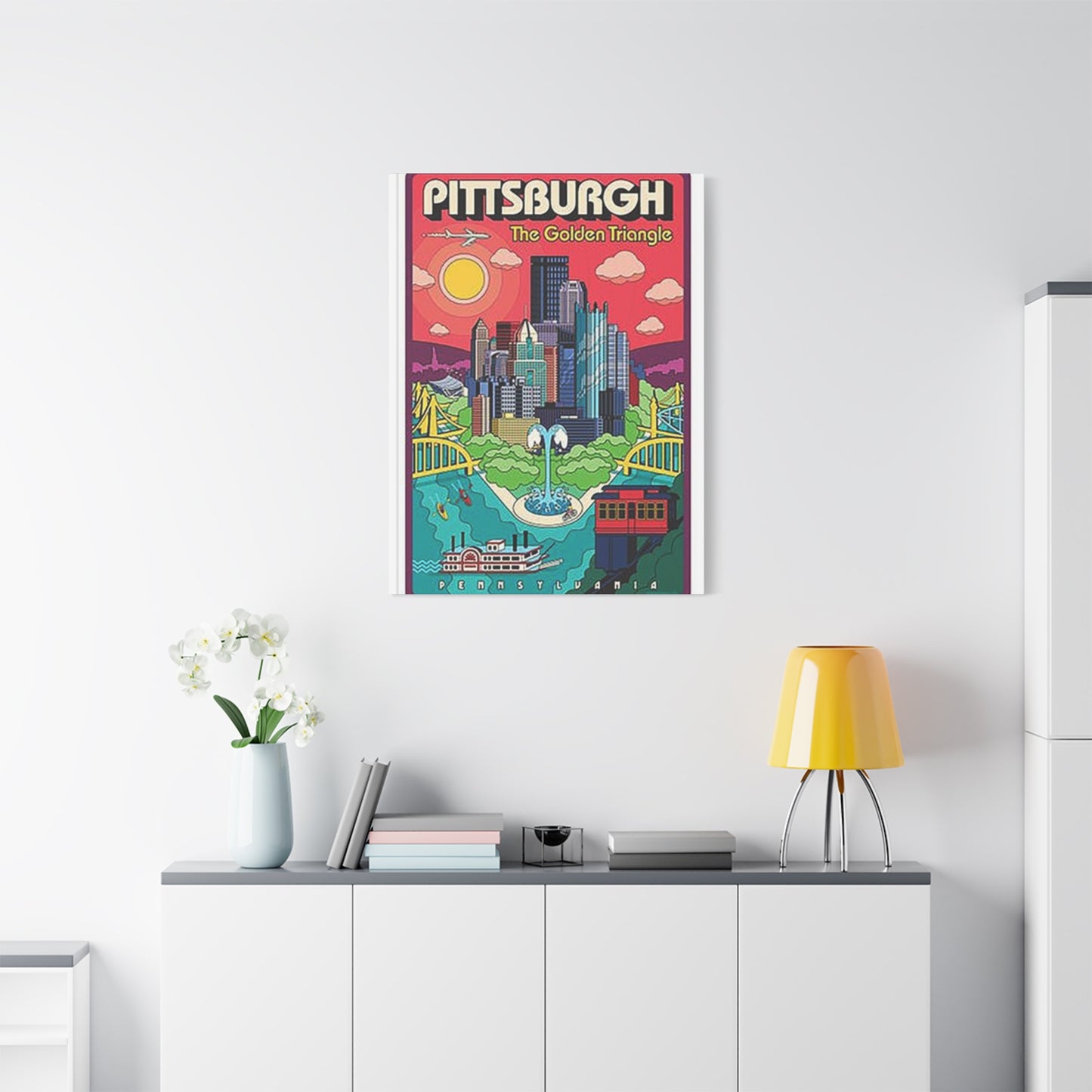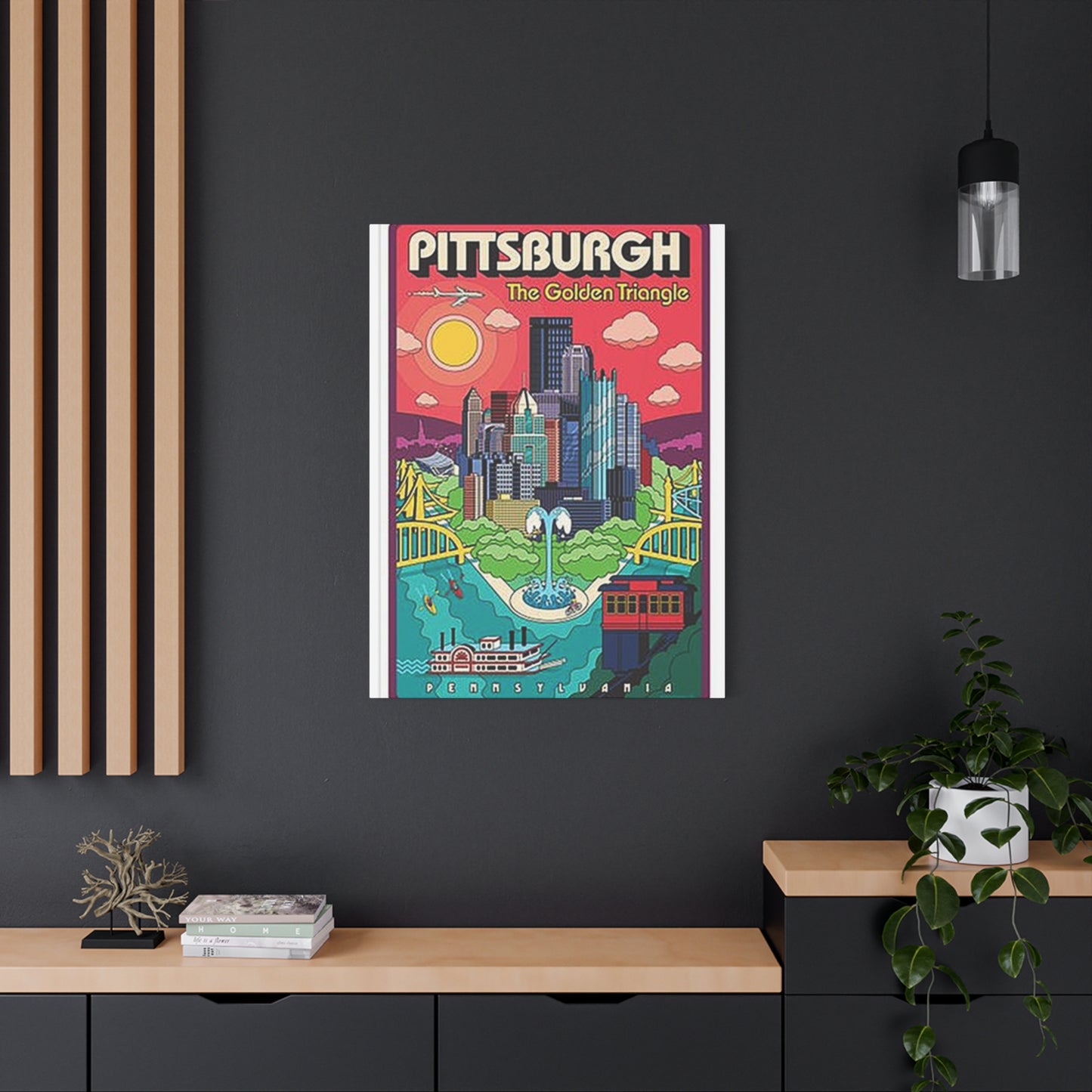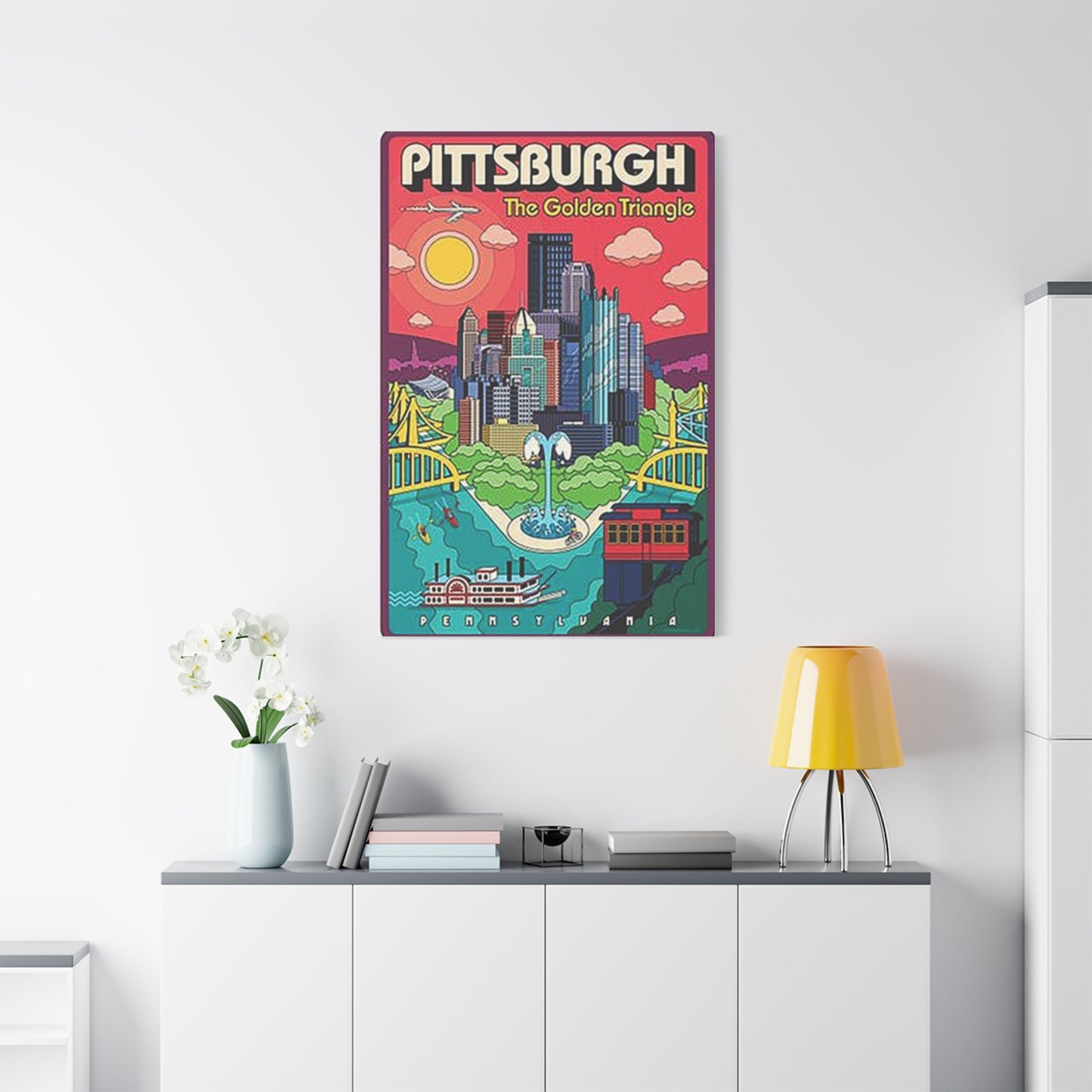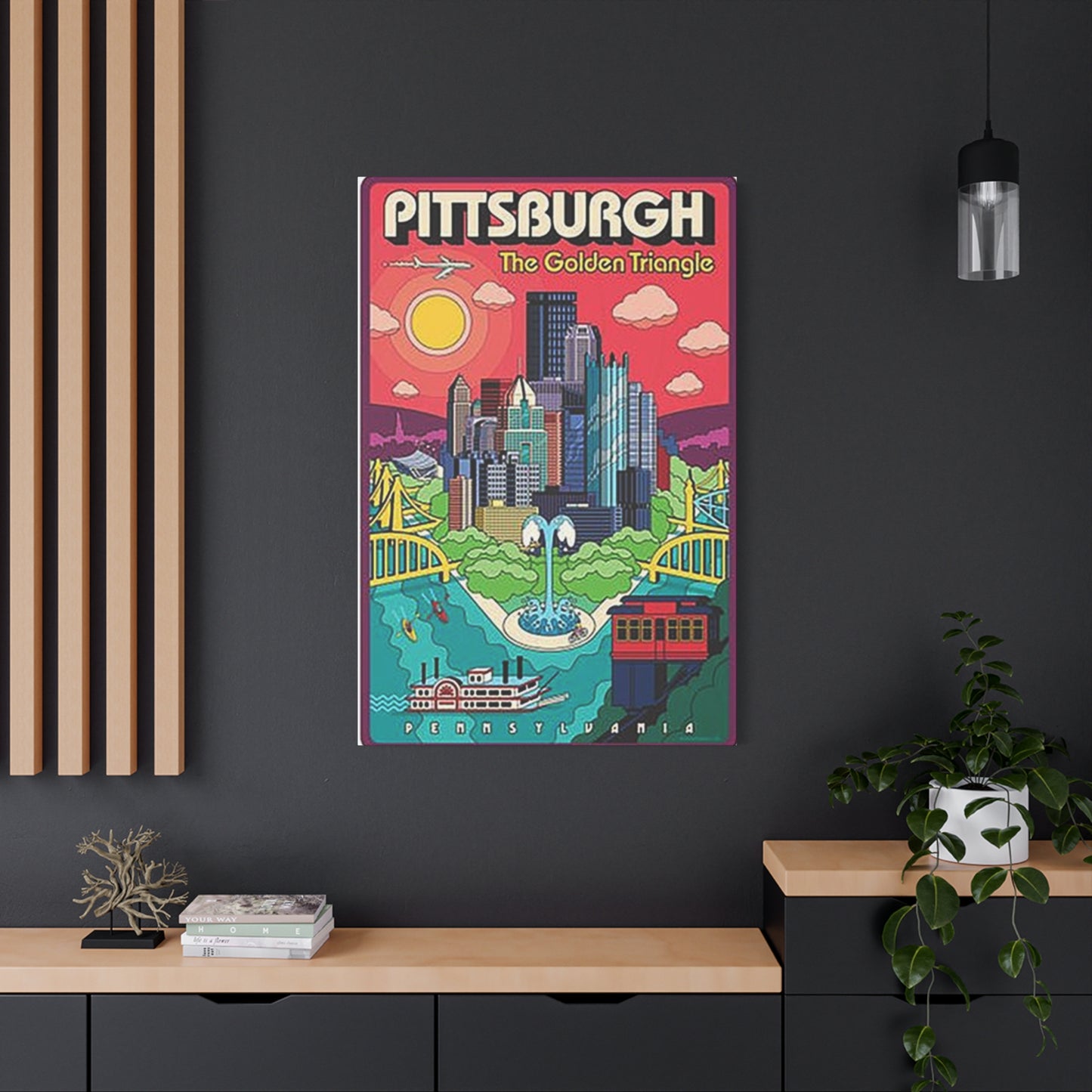Pittsburgh Golden Triangle Wall Art: A Symbol of City Pride and Identity
The fascination with Pittsburgh's Golden Triangle has transcended geographical boundaries, capturing the imagination of art enthusiasts, urban design aficionados, and those who appreciate the remarkable transformation of American industrial cities. This distinctive triangular wedge of land where the Allegheny and Monongahela rivers converge to form the Ohio River represents more than just a geographical feature. It embodies the spirit of regeneration, architectural innovation, and urban resilience that has come to define modern Pittsburgh. When translated into poster wall art and canvas prints, this iconic landscape becomes a powerful statement piece that brings sophistication, history, and visual interest to any interior space.
The Golden Triangle's visual appeal stems from its unique combination of natural beauty and human achievement. The dramatic riverside setting, punctuated by bridges that have become architectural landmarks in their own right, creates a skyline that photographers and artists find endlessly compelling. The interplay of steel structures, glass facades, and waterways produces a dynamic composition that changes with the seasons, weather conditions, and time of day. This natural variability makes Golden Triangle artwork particularly versatile, as different interpretations can evoke vastly different moods and aesthetic responses.
Canvas prints featuring this remarkable urban landscape have become increasingly popular among interior designers, homeowners, and commercial space planners who recognize the power of place-based artwork to create atmosphere and conversation. Unlike generic cityscape prints, Pittsburgh Golden Triangle artwork carries specific cultural resonance while maintaining broad visual appeal. The combination of recognizable landmarks, striking compositional elements, and rich historical context creates artwork that functions on multiple levels simultaneously.
The Historical Significance Behind Golden Triangle Imagery
Understanding the historical context of Pittsburgh's Golden Triangle enriches the appreciation of artwork depicting this remarkable urban space. The area's development from industrial powerhouse to modern business district represents one of the most successful urban transformations in American history. During the nineteenth and early twentieth centuries, this convergence of rivers served as the beating heart of American steel production, earning Pittsburgh the nickname "Steel City" and establishing its reputation as an industrial titan that powered national growth and development.
The environmental and economic challenges that followed the decline of heavy industry could have spelled disaster for this urban core. Instead, civic leaders, business innovators, and community stakeholders collaborated on an ambitious revitalization project that transformed the Golden Triangle from a smoke-filled industrial zone into a vibrant business district characterized by green spaces, cultural institutions, and architectural distinction. This remarkable transformation story adds layers of meaning to Golden Triangle artwork, making each print a testament to human adaptability and urban resilience.
Historical photographs and artistic renderings from different eras reveal the dramatic changes this landscape has undergone. Early twentieth-century images show a skyline dominated by industrial smokestacks and factories, while contemporary photographs showcase gleaming office towers, cultural venues, and carefully designed public spaces. This historical progression makes Golden Triangle artwork particularly meaningful for those interested in urban development, industrial history, or the broader narrative of American economic evolution.
The architectural landmarks within the Golden Triangle tell stories of different eras and design philosophies. From the Romanesque Revival grandeur of the Allegheny County Courthouse to the modernist elegance of the Gulf Tower and the contemporary innovation of PPG Place, the district showcases architectural diversity that spans more than a century. Each building contributes to the visual complexity that makes Golden Triangle artwork so compositionally rich and visually engaging.
Artistic Styles and Interpretations of Pittsburgh Skyline Art
The versatility of Pittsburgh Golden Triangle imagery allows for diverse artistic interpretations, each offering unique aesthetic qualities and emotional resonance. Photographic prints capture the landscape with documentary precision, preserving architectural details, lighting conditions, and atmospheric qualities that define specific moments in time. These realistic representations appeal to those who appreciate authentic cityscapes and want artwork that accurately reflects the physical reality of this urban environment.
Contemporary photographers employ various techniques to elevate Golden Triangle imagery beyond simple documentary photography. Long exposure techniques transform moving water and clouds into ethereal elements that contrast with the solidity of architectural structures. High dynamic range processing brings out details in both shadow and highlight areas, creating images with exceptional depth and visual impact. Drone photography offers previously impossible perspectives, revealing the geometric patterns and spatial relationships that define this urban landscape from above.
Illustrated interpretations of the Golden Triangle skyline offer different aesthetic possibilities. Vector graphics create clean, stylized representations that emphasize geometric forms and bold color relationships. These modernist interpretations work particularly well in contemporary interiors where simplified forms and graphic clarity align with minimalist design principles. The reduction of complex architectural details to essential shapes and colors creates artwork that functions as both representation and abstraction.
Watercolor treatments bring softness and romanticism to Golden Triangle imagery. The fluid nature of watercolor paint creates atmospheric effects that emphasize mood over precision, with colors bleeding into one another to suggest rather than define architectural forms. These interpretations appeal to those seeking artwork that evokes emotional responses rather than providing architectural documentation. The gentle quality of watercolor paintings can soften the hard edges of urban environments, making them particularly suitable for residential spaces seeking balance between urban energy and domestic tranquility.
Abstract interpretations push further from literal representation, using the Golden Triangle as inspiration rather than subject. These works might capture the energy and rhythm of the urban landscape through color relationships, gestural marks, or compositional structures that reference rather than depict specific buildings or landmarks. Such interpretations offer maximum flexibility in terms of color coordination and stylistic integration with diverse interior design schemes.
Selecting the Perfect Canvas Print for Your Interior Space
Choosing the right Pittsburgh Golden Triangle canvas print involves considering multiple factors that influence how artwork functions within a specific interior environment. Size represents the most fundamental consideration, as artwork must be appropriately scaled to the wall space it will occupy. A common mistake involves selecting prints that are too small for the available wall area, resulting in artwork that appears insignificant and fails to create the intended visual impact.
For large walls in living rooms, offices, or commercial spaces, oversized canvas prints measuring four feet or more in width create commanding focal points that anchor the entire room. These substantial pieces work best with images that contain sufficient detail and compositional strength to sustain interest at large scale. Panoramic compositions of the Golden Triangle skyline particularly suit wide wall spaces above sofas, credenzas, or conference room furniture.
Medium-sized prints ranging from two to three feet provide versatility for various applications. These dimensions work well in bedrooms, home offices, hallways, and smaller living spaces where wall area is more limited. At this scale, both wide panoramic compositions and more vertically oriented compositions can work effectively, depending on the specific wall proportions and surrounding furniture arrangements.
Smaller canvas prints measuring under two feet serve specialized functions within interior design schemes. They work effectively as part of gallery wall arrangements where multiple pieces are combined to create larger visual statements. They also function well in intimate spaces like bathrooms, small home offices, or breakfast nooks where larger artwork would overwhelm the available space.
Color palette represents another critical selection factor. Golden Triangle artwork typically features the blue tones of water and sky, the earth tones of bridges and older buildings, and the metallic grays of contemporary glass and steel architecture. Some interpretations emphasize these natural color relationships, while others introduce more dramatic color treatments through filters, lighting conditions, or artistic interpretation. The artwork's color palette should harmonize with existing interior colors while potentially introducing accent colors that add visual interest.
The time of day depicted in Golden Triangle imagery significantly impacts its mood and aesthetic effect. Daytime scenes emphasize architectural clarity and detail, with bright light revealing textures and spatial relationships. These images convey energy, activity, and optimism, making them appropriate for workspaces and public areas where alertness and engagement are valued. Evening and night scenes transform the skyline through artificial lighting, with illuminated buildings creating dramatic contrasts against darkened skies. These nocturnal views tend to feel more sophisticated and atmospheric, working well in entertainment spaces, restaurants, or residential rooms where ambiance matters more than functionality.
Weather conditions also influence the emotional character of Golden Triangle artwork. Clear skies create clean, optimistic images with strong architectural presence, while dramatic cloud formations add visual interest and emotional intensity. Fog and mist create mysterious, atmospheric effects that soften architectural edges and emphasize mood over clarity. Storm conditions introduce dynamic energy and dramatic lighting that can make artwork feel more powerful and intense.
Technical Considerations for Canvas Print Quality
Understanding the technical aspects of canvas print production helps ensure that purchased artwork meets expectations for visual quality and longevity. The printing technology used significantly impacts the final result, with giclée printing representing the highest quality standard for canvas reproduction. This process uses archival pigment inks and precision inkjet technology to create prints with exceptional color accuracy, tonal range, and detail resolution. Giclée prints resist fading far better than those produced with dye-based inks, maintaining their visual impact for decades when properly displayed and maintained.
Canvas material quality varies considerably among different manufacturers and price points. Professional-grade canvas uses tightly woven polyester or cotton fibers that provide smooth printing surfaces while maintaining enough texture to distinguish canvas prints from photographic paper prints. The weight of canvas fabric, measured in ounces per square yard, indicates its durability and resistance to sagging over time. Heavier canvas materials maintain tight stretching better and withstand environmental variations more effectively.
The stretching and framing process determines how finished canvas prints appear when hung. Gallery wrap construction stretches the printed canvas around wooden stretcher bars, with the image continuing around the sides of the frame. This technique creates finished edges that require no additional framing, producing a contemporary appearance appropriate for modern interiors. The depth of stretcher bars influences the dimensional presence of mounted prints, with thicker bars creating more pronounced shadow effects and greater physical presence.
Alternative framing approaches involve stretching canvas within traditional frames, either with or without glass protection. While this method provides more decorative options through frame selection, it also increases cost and weight while creating a more traditional aesthetic that may not suit contemporary Golden Triangle imagery. The choice between gallery wrap and traditional framing should reflect both aesthetic preferences and the overall design character of the space where artwork will be displayed.
Protective coatings applied to finished canvas prints enhance durability and simplify maintenance. UV-resistant coatings protect against sun damage that can cause colors to fade over time, while moisture-resistant treatments help prevent damage in humid environments. These protective measures are particularly important for prints displayed in areas with significant natural light exposure or environmental challenges like bathrooms or kitchens.
Incorporating Golden Triangle Art into Different Design Styles
The adaptability of Pittsburgh Golden Triangle artwork allows successful integration into diverse interior design styles, each requiring different approaches to selection and presentation. In contemporary interiors characterized by clean lines, neutral color palettes, and minimalist sensibilities, Golden Triangle prints should emphasize graphic clarity and compositional simplicity. Black and white interpretations or limited color palettes work particularly well, as do images with strong geometric elements that echo the rectilinear forms common in contemporary design.
Industrial design schemes naturally complement Golden Triangle imagery given Pittsburgh's industrial heritage. Exposed brick, concrete floors, metal fixtures, and raw wood elements create environments where urban skyline artwork feels contextually appropriate. In these settings, prints might emphasize the bridges, steel structures, and industrial elements within the Golden Triangle landscape. Gallery wrap canvas mounted directly to walls without additional framing maintains the raw, unfinished aesthetic that defines industrial design.
Traditional interiors require more careful integration of urban skyline artwork, as the contrast between classical design elements and contemporary subject matter can create visual discord if not thoughtfully managed. Selecting Golden Triangle images with more atmospheric, painterly qualities helps bridge this stylistic gap. Traditional framing with substantial moldings can also help urban imagery feel more at home among period furniture and classical architectural details.
Transitional spaces that blend traditional and contemporary elements offer ideal environments for Golden Triangle artwork. These interiors typically feature neutral color schemes, mixed furniture styles, and balanced combinations of classical and modern details. In such settings, Golden Triangle prints can serve as focal points that lean contemporary while remaining compatible with more traditional surrounding elements. Selecting images with balanced color palettes and avoiding overly dramatic or stylized interpretations helps maintain the harmonious character essential to successful transitional design.
Eclectic interiors that deliberately mix diverse styles, periods, and cultural references can accommodate bolder, more dramatic interpretations of Golden Triangle imagery. In these maximalist environments, artwork competes with numerous other visual elements, requiring sufficient scale, color intensity, or compositional drama to maintain presence. Large-scale prints with saturated colors or unusual perspectives work well in eclectic spaces where visual excitement matters more than coordination.
Optimal Placement and Hanging Strategies for Maximum Impact
Strategic placement of Golden Triangle canvas prints maximizes their visual impact and enhances overall interior design effectiveness. In living rooms, the wall above the sofa represents the most common location for large-scale artwork, creating a focal point that anchors seating arrangements and establishes the room's design character. When hanging artwork above sofas, the bottom edge of the canvas should typically sit eight to twelve inches above the furniture to create proper visual connection while maintaining functional clearance.
Centering artwork horizontally on the wall provides classical balance, while asymmetrical placement can create more dynamic, contemporary arrangements. When using single large prints, centered placement usually works best. Multiple smaller prints arranged as gallery walls offer more flexibility for asymmetrical compositions that create visual interest through deliberate imbalance.
Dining rooms provide excellent opportunities for Golden Triangle artwork, as walls adjacent to or facing dining tables benefit from visually engaging focal points that stimulate conversation. The horizontal orientation of most dining tables pairs naturally with panoramic skyline compositions. Proper lighting becomes particularly important in dining areas, as artwork should remain visible during evening meals when artificial lighting dominates.
Home offices and studies require artwork that maintains professional character while providing visual interest that breaks up work-related monotony. Golden Triangle prints positioned within the normal sight line of seated workers offer occasional visual breaks that can reduce eye strain and mental fatigue. However, artwork should not be placed in positions that create screen glare or distraction from primary work activities.
Bedroom artwork requires special consideration of both aesthetics and psychology. While some individuals find urban skyline imagery energizing and inspiring, others may prefer more calming subjects for sleeping spaces. When incorporating Golden Triangle prints in bedrooms, consider placement above headboards where artwork remains visible but not directly within the primary sight line when lying in bed. Selecting images with softer lighting, atmospheric qualities, or muted colors can help urban skyline art function successfully in relaxation-oriented spaces.
Hallways and transitional spaces often receive insufficient attention in interior design planning, yet they offer valuable opportunities for artwork display. Long corridors particularly suit series of smaller Golden Triangle prints or single panoramic compositions that complement the linear architecture of hallway spaces. Proper lighting becomes critical in hallways, which often lack natural light and require dedicated picture lighting or ceiling fixtures that illuminate artwork effectively.
Commercial spaces including offices, restaurants, hotels, and retail environments use Golden Triangle artwork to establish local identity, create sophisticated atmospheres, and fill large wall expanses that would otherwise feel stark and unwelcoming. In these applications, scale typically needs to be substantial, with multiple large prints or single oversized pieces creating sufficient impact to register in busy, often large-scale environments. Durability and professional installation become more critical in commercial applications where artwork represents significant investment and must withstand higher traffic and environmental variation.
Creating Gallery Wall Arrangements with Multiple Canvas Prints
Gallery walls that combine multiple Pittsburgh Golden Triangle prints create dynamic, personalized displays that offer more visual complexity than single large pieces. This approach works particularly well when working with various sized prints, different perspectives of the same location, or mixing Golden Triangle imagery with complementary subjects like close-up architectural details, bridge photographs, or historical images of Pittsburgh.
The first step in creating effective gallery walls involves laying out the arrangement on the floor or using paper templates attached to the wall with removable tape. This planning phase allows experimentation with different configurations without creating unnecessary holes in walls. Successful gallery wall arrangements typically maintain relatively consistent spacing between frames, with two to four inches of space creating visual separation while maintaining overall unity.
Several organizational strategies can guide gallery wall composition. Grid arrangements place prints in regular rows and columns, creating orderly, structured displays with strong geometric presence. This approach works best when all prints share identical frame sizes and when the overall design scheme favors order and precision. Asymmetrical arrangements create more organic, dynamic displays by varying print sizes and positions. These layouts require more careful planning to achieve visual balance while avoiding chaotic appearance.
Central anchor arrangements build gallery walls around one dominant large print, with smaller complementary pieces surrounding it. This approach provides clear focal hierarchy while allowing inclusion of multiple images. The central print should be the largest and most visually commanding piece, positioned approximately at eye level with surrounding pieces arranged to balance the composition.
Color coordination becomes particularly important when combining multiple prints in gallery walls. Selecting images that share common color elements helps create unity despite diversity of specific subjects and compositions. Alternatively, deliberately contrasting color schemes can create dynamic tension that energizes spaces, though this approach requires more design sophistication to execute successfully.
Mixing different artistic styles within gallery walls adds visual interest but requires careful balance to avoid incoherence. Combining photographic prints with illustrated interpretations can work effectively when shared subject matter and color relationships provide sufficient unity. The key involves maintaining enough similarity that pieces feel related while offering enough variation to justify displaying multiple prints rather than a single large piece.
The Psychology of Urban Landscape Art in Interior Environments
Understanding how Golden Triangle artwork affects human psychology and behavior in interior environments helps inform more intentional selection and placement decisions. Urban landscape imagery generally projects energy, ambition, and forward-thinking attitudes, making it psychologically appropriate for spaces associated with work, creativity, and productivity. The verticality of skyline compositions naturally directs attention upward, creating subtle psychological effects associated with aspiration and achievement.
Photographs that emphasize water features within the Golden Triangle landscape introduce calming elements that can moderate the stimulating energy of architectural forms. The presence of rivers in Golden Triangle imagery creates psychological associations with flow, movement, and natural processes that humanize otherwise entirely built environments. This combination of natural and constructed elements contributes to the psychological complexity that makes urban landscape artwork interesting to contemplate over extended periods.
The time of day depicted in Golden Triangle prints influences their psychological impact. Morning light suggests new beginnings, optimism, and fresh starts, making dawn images psychologically appropriate for spaces associated with planning, strategizing, and initiating projects. Midday images convey peak activity and full engagement, supporting environments where alertness and energy are valued. Evening and night images create more contemplative, sophisticated moods appropriate for relaxation, conversation, and reflection.
Scale perception in urban artwork creates psychological effects related to human relationship with built environments. Photographs taken from river level emphasize the monumentality of architecture, creating slight psychological overwhelm that can feel either impressive or intimidating depending on context and individual disposition. Aerial perspectives reduce this monumentality, presenting the urban landscape as comprehensible and manageable, which can create psychological comfort and sense of mastery over environment.
The presence of human figures in Golden Triangle imagery, even when small or distant, significantly affects psychological response. Images showing people create narrative possibilities and emotional connection, as viewers imagine themselves within the depicted scene. Conversely, unpopulated urban landscapes emphasize architecture and formal relationships, creating more abstract, contemplative responses less connected to personal experience.
Historical resonance embedded in Golden Triangle imagery triggers psychological responses related to place identity, civic pride, and connection to broader narratives beyond individual experience. For Pittsburgh residents and those with personal connections to the city, Golden Triangle artwork can function as identity expression and tangible connection to place. For others, it represents engagement with urban transformation narratives and appreciation for architectural achievement independent of specific geographical connection.
Maintaining and Preserving Canvas Print Quality Over Time
Proper maintenance and environmental management significantly extend the lifespan and preserve the visual quality of Pittsburgh Golden Triangle canvas prints. The primary threat to print longevity comes from ultraviolet radiation in sunlight, which gradually breaks down ink pigments and causes colors to fade. While professional giclée prints using archival pigment inks resist fading far better than those produced with dye-based inks, prolonged direct sunlight exposure will eventually cause degradation even with highest quality prints.
Positioning canvas prints away from windows that receive direct sunlight provides the most effective protection against UV damage. When wall space limitations necessitate placement near windows, UV-filtering window films or treatments can significantly reduce harmful radiation while maintaining natural light. UV-protective coatings applied to canvas surfaces during finishing also provide substantial protection, though they do not eliminate the need for thoughtful placement decisions.
Humidity control protects canvas prints from several deterioration mechanisms. High humidity can cause mold growth on canvas fibers, create conditions for adhesive failure where canvas attaches to stretcher bars, and cause warping or loosening of stretched canvas. Maintaining indoor relative humidity between thirty and fifty percent protects artwork while remaining comfortable for human occupancy. Areas with particularly high humidity like bathrooms require extra caution, with exhaust fans, dehumidifiers, or alternative artwork choices representing potential solutions.
Temperature stability matters less than humidity control for canvas preservation, though extreme heat can accelerate chemical degradation processes. Avoiding placement near heating vents, fireplaces, or other heat sources protects against temperature-related damage while also preventing uneven heating that can cause warping or sagging.
Dust accumulation represents the most common maintenance requirement for canvas prints. Regular gentle dusting using soft, clean cloths or feather dusters prevents buildup that can become embedded in canvas texture. Avoid using water or cleaning solutions unless absolutely necessary, as moisture can damage canvas fibers and cause ink bleeding. If cleaning beyond dusting becomes necessary, professional art conservation services provide expertise that prevents damage from improper cleaning techniques.
Physical damage from impacts, abrasion, or punctures requires more care with canvas prints than with framed prints protected by glass. Positioning artwork away from high-traffic areas where contact is likely protects against accidental damage. In homes with children or pets, mounting prints higher on walls or selecting locations outside play areas prevents damage from thrown objects, curious hands, or pet interactions.
Periodic inspection of stretcher bar connections and canvas tension helps identify problems before they cause visible damage. Canvas naturally relaxes slightly over time, sometimes requiring re-stretching to maintain proper tension and appearance. This maintenance typically requires professional services, as improper stretching techniques can damage canvas or create visible distortions.
Customization Options for Personalized Golden Triangle Artwork
Many providers offer customization options that allow creation of truly unique Pittsburgh Golden Triangle canvas prints tailored to specific preferences and requirements. Color customization represents the most accessible modification, with many images available in multiple color treatments ranging from natural full-color reproduction through selective coloring emphasizing specific elements to complete conversion to monochrome or sepia tones. These color modifications dramatically alter the mood and style of artwork while maintaining the recognizable Golden Triangle subject matter.
Perspective selection provides another customization avenue, as the Golden Triangle can be photographed from numerous vantage points around its perimeter and from elevated positions in surrounding neighborhoods. Some individuals prefer classic views from river level that emphasize the convergence of waterways and downtown skyline, while others favor perspectives from Mount Washington or other elevated positions that reveal the geometric patterns and spatial relationships less visible from ground level.
Seasonal variations create different aesthetic qualities in Golden Triangle imagery. Spring photographs feature fresh green foliage and renewed growth, summer images show full canopy development and bright light, autumn provides dramatic foliage colors that complement urban architecture, and winter scenes offer stark contrasts between snow-covered landscapes and dark architectural forms. Selecting imagery from specific seasons allows artwork to reflect personal preferences or commemorate meaningful times.
Temporal specificity through custom photography creates artwork connected to particular moments of personal significance. Commissioning photographers to capture the Golden Triangle during specific events, at particular times, or under desired weather conditions produces unique artwork unavailable through standard commercial offerings. While more expensive than purchasing existing images, this approach creates genuinely one-of-a-kind pieces with personal narrative significance.
Text additions represent another customization possibility, though they require careful design consideration to avoid compromising visual composition. Adding date information, quotations, or personal messages can increase sentimental value while potentially limiting broader appeal. Typography selection, positioning, and size all require attention to maintain visual harmony between text elements and underlying imagery.
Cropping and aspect ratio adjustments allow standard images to be modified for specific spatial requirements. While most Golden Triangle photographs naturally lend themselves to horizontal panoramic formats, creative cropping can produce square or vertical compositions that suit different wall spaces. However, aggressive cropping can sacrifice compositional integrity if not handled skillfully, as photographers typically compose images with specific aspect ratios in mind.
Combining Golden Triangle imagery with other visual elements through photomontage or digital composition creates hybrid artworks that transcend simple photographic reproduction. These might incorporate historical imagery, textual elements, graphic design components, or abstract visual elements that add layers of meaning and visual complexity. Such compositions require professional design skills to execute successfully but can produce truly unique artwork impossible to find through standard commercial channels.
Exploring Different Perspectives and Vantage Points
The visual character of Pittsburgh Golden Triangle artwork varies dramatically based on the specific perspective and vantage point from which the landscape is captured. Understanding these differences helps in selecting images that achieve desired aesthetic effects and functional goals within interior spaces. River-level perspectives, typically captured from Point State Park at the convergence of the three rivers, emphasize the monumental scale of downtown architecture while incorporating substantial sky and water elements that balance the built environment with natural features.
These ground-level views create compositions where the viewer appears to stand within the landscape rather than observing it from distance. This creates psychological engagement and sense of place that more distant perspectives cannot achieve. The inclusion of foreground elements like park features, river edges, or pedestrian areas adds depth and spatial complexity that makes compositions more visually interesting than simple skyline silhouettes against sky.
Elevated perspectives from Mount Washington or Grandview Avenue provide the most iconic views of the Golden Triangle, offering commanding overviews that reveal the full extent of the downtown peninsula and its geometric relationship to surrounding waterways and neighborhoods. These elevated positions reduce the sense of monumentality present in ground-level views, presenting the urban landscape as comprehensible and visually organized. The height advantage allows photographers to create layered compositions with foreground, middle ground, and background elements that create strong three-dimensional spatial effects in two-dimensional artwork.
The specific elevation of vantage points significantly affects compositional character. Lower elevations maintain more architectural detail and create more compressed, dense compositions, while higher positions reduce detail in favor of broader spatial relationships and pattern recognition. The angle of view also matters, with head-on perspectives creating symmetrical compositions while oblique angles introduce dynamic tension through asymmetry.
Bridge perspectives offer unique vantage points that incorporate the structural elements of the bridges themselves as compositional components. Shooting from bridge walkways or roadways toward downtown creates compositions where massive bridge cables, towers, or structural elements occupy foreground space while the Golden Triangle skyline provides background context. These perspectives connect viewers with the experience of moving through the urban landscape rather than simply observing it from static positions.
Aerial perspectives captured by drones or from aircraft provide contemporary viewpoints that were largely unavailable until recent technological advances. These bird's-eye views reveal geometric patterns, spatial relationships, and urban organization invisible from ground level. The dramatic shift in perspective creates abstract qualities even when depicting recognizable locations, as familiar landmarks appear in unfamiliar configurations.
Water-level perspectives taken from boats or kayaks on the rivers introduce dynamic, unstable viewpoints that contrast with the solidity of the urban landscape. The low vantage point emphasizes architectural height while the waterborne position creates compositions where reflections play significant roles. These perspectives tend to feel more active and experiential, conveying sense of movement and exploration rather than static observation.
Pairing Golden Triangle Art with Complementary Decorative Elements
Successful interior design extends beyond artwork selection to include thoughtful coordination with surrounding decorative elements that enhance overall aesthetic impact. Lighting represents the most critical complementary element, as even the finest artwork cannot achieve its potential without proper illumination. Picture lights mounted above canvas prints provide focused illumination that enhances color saturation and reveals textural details while creating dramatic lighting effects that draw attention to artwork.
Track lighting systems offer flexibility for illuminating multiple artworks or adjusting light direction to accommodate changing displays. Adjustable fixtures allow precise control over light angle and spread, minimizing glare while maximizing visual impact. When using track lighting for Golden Triangle canvas prints, position fixtures approximately thirty degrees from vertical to create optimal illumination without creating hot spots or excessive glare from canvas texture.
Ambient lighting in rooms containing Golden Triangle artwork should be planned to maintain appropriate brightness ratios between artwork and surrounding spaces. Excessive contrast between brightly lit artwork and dark surroundings creates visual strain, while insufficient contrast fails to emphasize artwork as intended focal point. Dimmer controls provide flexibility to adjust lighting for different times of day and activities.
Furniture placement in relation to Golden Triangle artwork influences viewing experience and overall room functionality. Seating arranged to face artwork creates opportunities for comfortable contemplation, while positioning pieces perpendicular to walls creates more casual viewing situations. The distance between artwork and primary viewing positions affects detail visibility and compositional impact, with closer viewing emphasizing details and textures while distant viewing emphasizes overall composition and color relationships.
Complementary decorative objects can enhance Golden Triangle artwork themes without creating redundancy or visual competition. Industrial objects like vintage gears, architectural salvage pieces, or metal sculptures reference Pittsburgh's industrial heritage while adding three-dimensional interest. However, restraint remains important, as excessive thematic coordination can feel contrived and diminish rather than enhance sophisticated design.
Color coordination between Golden Triangle artwork and surrounding decorative elements creates visual harmony that enhances both artwork and overall space. Accent pillows, throws, rugs, or decorative objects that incorporate colors present in the artwork create subtle visual connections that tie design schemes together. This coordination should feel natural rather than overly matched, with variations in shade, saturation, and value preventing design from feeling too controlled or artificial.
Window treatments affect both the preservation and presentation of Golden Triangle canvas prints. Heavy curtains or blinds that block direct sunlight protect artwork from UV damage while also providing opportunities to control ambient light levels for optimal viewing. The color and texture of window treatments should coordinate with artwork without creating visual competition, with neutral tones typically working most effectively.
Architectural features including moldings, wainscoting, or wall colors provide context that affects how Golden Triangle artwork appears. Neutral wall colors allow artwork to command maximum attention, while strongly colored walls create more integrated appearances where artwork becomes one element within a broader color scheme. The choice between these approaches depends on whether design intent emphasizes artwork as primary focal point or as one component within a more complex integrated design.
Understanding Print Resolution and Image Quality Standards
Technical image quality significantly impacts the visual success of Pittsburgh Golden Triangle canvas prints, making understanding resolution, file formats, and printing standards essential for anyone purchasing or commissioning custom artwork. Resolution refers to the amount of detail an image contains, typically measured in pixels per inch for digital images. For canvas prints, minimum resolution requirements vary with final print size, with larger prints requiring higher resolution source images to maintain acceptable quality.
Professional photographers and print providers typically recommend minimum resolutions of 150 to 300 pixels per inch at final print size for canvas prints. While this is lower than the 300 DPI standard for photographic prints, canvas texture naturally softens fine details, making ultra-high resolution less critical. However, images with insufficient resolution produce visible pixelation and loss of detail that significantly compromises visual quality, particularly in prints larger than two feet in any dimension.
File formats affect both image quality and production workflow. Professional photographers deliver images in RAW format, which preserves maximum information and allows extensive post-processing without quality loss. For final printing, TIFF format provides lossless compression that maintains all image data, while high-quality JPEG files offer smaller file sizes with minimal visible quality loss when saved at maximum quality settings. Lower quality JPEG compression creates visible artifacts that become increasingly apparent as print size increases.
Color space management ensures that colors in final prints accurately represent photographer or artist intentions. The Adobe RGB color space captures wider color gamut than the more common sRGB space, allowing reproduction of more saturated colors particularly in greens and blues common in Golden Triangle landscape imagery. Professional print services should accept Adobe RGB files and maintain proper color management throughout production to prevent unwanted color shifts.
Dynamic range refers to the span between darkest and brightest areas an image can capture and reproduce. Golden Triangle scenes often involve high dynamic range situations with bright skies and dark architectural shadows. High-quality source images maintain detail in both shadow and highlight areas rather than showing blocked shadows or blown highlights. HDR processing techniques can expand dynamic range beyond what single exposures capture, though excessive HDR processing can create unnatural appearances that some viewers find objectionable.
Sharpness and focus quality determine how crisp details appear in final prints. Professional architectural photography uses techniques including tripod stabilization, optimal aperture selection, and precise focusing to maximize sharpness. When evaluating potential Golden Triangle prints, examine detail areas at full resolution to ensure critical elements show sharp focus rather than blur or softness that will become more apparent when enlarged to canvas print size.
Seasonal Variations and Their Impact on Golden Triangle Imagery
The seasonal cycle dramatically transforms the appearance of Pittsburgh's Golden Triangle, creating distinct aesthetic characters that appeal to different preferences and design objectives. Spring brings renewal and fresh growth, with trees developing bright green foliage that softens the hard edges of urban architecture. The quality of spring light tends toward clarity and freshness, with longer days and higher sun angles creating bright, optimistic imagery. Spring photographs work particularly well in spaces seeking to convey renewal, growth, and forward-looking energy.
Early spring presents interesting transitional characteristics, with some trees fully leafed while others remain bare, creating varied textures and visual interest. The mix of greens, browns, and grays in early spring landscapes provides complex color palettes that coordinate well with diverse interior schemes. Late spring transitions toward summer's full canopy, with increasingly lush vegetation partially obscuring buildings and creating more balanced relationships between natural and built elements.
Summer presents the Golden Triangle in its most vegetated state, with full tree canopy creating maximum integration between urban development and natural landscape elements. The point where the three rivers meet features Point State Park, and summer photography shows this space at its most lush and active, often including people enjoying recreational activities. Summer light characteristics include longer days, warmer color temperatures, and the potential for dramatic afternoon and evening lighting conditions.
Summer weather variability creates opportunities for diverse imagery. Clear sunny days produce bright, high-contrast images with deep blue skies, while partly cloudy conditions create more dramatic skies with interesting cloud formations. Summer storms generate some of the most dramatic Golden Triangle photographs, with dark threatening skies, dramatic lighting, and atmospheric conditions that create powerful emotional impact.
Autumn transforms the Golden Triangle landscape through spectacular foliage color changes. The deciduous trees surrounding the downtown area develop brilliant reds, oranges, and yellows that provide warm color contrasts to the cool grays and blues of architecture, sky, and water. Autumn Golden Triangle prints offer some of the most visually striking color relationships available in cityscape photography, with natural warm tones contrasting beautifully with urban cool tones.
The progression through autumn provides multiple distinct looks as foliage color transitions from summer green through peak fall colors to late-season brown. Peak fall color typically occurs in mid-October in Pittsburgh, creating a brief window for the most spectacular autumn imagery. Early autumn retains more green with beginning color change, while late autumn features mostly bare trees with brown leaves and increasingly stark landscape character.
Winter presents the Golden Triangle in its most austere form, with bare trees revealing architectural forms more completely than during leafed seasons. Snow cover transforms the landscape dramatically, creating strong value contrasts between white ground surfaces and dark buildings. Winter light quality differs markedly from other seasons, with lower sun angles creating longer shadows, warmer color temperatures during limited daylight hours, and the potential for flat overcast conditions during snow events.
Winter weather creates the most dramatic variations in Golden Triangle appearance. Fresh snow creates pristine white surfaces and soft atmospheric conditions, while melting snow produces less attractive gray slush. Foggy winter conditions create mysterious atmospheric effects, with buildings emerging partially from obscuring mist. Ice formation on rivers and fountains adds interesting textural elements absent in warmer seasons.
The seasonal choice for Golden Triangle artwork should reflect both aesthetic preferences and the intended use context. Residential spaces might select seasons reflecting personal connections or favorite times of year, while commercial spaces might choose seasonal imagery strategically to reinforce brand messages or create desired emotional responses. Some spaces benefit from rotating seasonal prints that maintain visual freshness and mark passage of time.
Architectural Landmarks Within Golden Triangle Compositions
Understanding the specific architectural landmarks that appear in Pittsburgh Golden Triangle artwork enriches appreciation and helps in selecting images that resonate with particular interests or historical connections. The Point State Park fountain at the convergence of the three rivers represents one of the most iconic features, appearing prominently in many Golden Triangle photographs. This fountain symbolizes Pittsburgh's relationship with its rivers and serves as a focal point that draws the eye in compositions including the downtown skyline.
The courthouse complex along Grant Street features Romanesque Revival architecture that provides historical continuity within the otherwise modern urban landscape. The massive stone construction and distinctive tower create visual anchors in photographs that include this area, representing late nineteenth-century civic architecture at its most impressive. The warm stone tones contrast effectively with surrounding modern glass and steel structures.
Conclusion
The Golden Triangle is Pittsburgh’s heart — where the Allegheny and Monongahela Rivers meet to form the Ohio, framed by the city’s distinctive skyline. As an emblem of the city’s geography, history, and culture, the Golden Triangle offers a unique and powerful motif for wall art. Whether showcased through posters, canvas prints, or other forms of visual décor, its imagery brings both aesthetic beauty and a deep sense of place into any room.
Throughout this guide, we’ve explored how Pittsburgh Golden Triangle poster and canvas art can transform your environment by connecting you to the city’s identity. These pieces are more than decoration; they’re storytelling devices, capturing the geometry and flow of the city’s landscape in ways that inspire and captivate. From minimalist line art emphasizing shape and form to vivid photographic panoramas showcasing light and color, Golden Triangle art offers something for every style and taste.
Incorporating this iconic imagery into your space helps foster a connection to Pittsburgh’s heritage — a city renowned for its industrial grit, architectural beauty, and vibrant communities. The sharp angles and river convergences of the Golden Triangle evoke movement, energy, and unity, qualities that resonate with urban dwellers and art lovers alike. This makes such artwork ideal for homes, offices, studios, and public spaces where inspiration and identity matter.
From a design standpoint, Golden Triangle wall art offers remarkable versatility. Its geometric simplicity allows it to complement both modern and traditional interiors. Large-scale canvas prints can serve as bold focal points that anchor a room, while smaller posters can add subtle touches of personality on gallery walls or in cozy nooks. The use of metallic gold accents, deep blues, or monochromatic palettes further enhances its appeal, enabling customization to suit various color schemes and moods.
Emotional resonance is another key aspect of Golden Triangle artwork. For Pittsburgh residents and admirers, these prints act as visual love letters — reminders of the city’s resilience, its rivers that shaped commerce and culture, and the neighborhoods that form its diverse tapestry. Displaying such art encourages daily reflection on place and belonging, strengthening the bond between individual and community.
Artists and photographers who capture the Golden Triangle bring a fresh perspective to familiar vistas. Their work transforms an everyday urban feature into a timeless symbol of Pittsburgh’s evolving story. Whether through abstract interpretations, detailed mapping, or atmospheric renderings, their creations enrich the dialogue between city, viewer, and space.
In conclusion, Pittsburgh Golden Triangle poster and canvas art offers a compelling way to transform your space with iconic city imagery. This art form bridges the gap between geography and design, history and modernity, personal identity and collective memory. Bringing the Golden Triangle into your home or workplace means more than adding beauty — it means embracing the spirit of a city shaped by rivers, bridges, and the people who call it home.

















